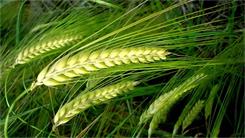2. The annual rainfall for safe wheat production must be between 10 to 70 inches.
3. Disease and insect resistance is the main characteristic to be considered in selecting the variety.
4. The origin of wheat is unknown.
5. Winter wheat is more widely grown than spring wheat in regions where it can over-winter successfully.
6. Warm or moist climates generally reduce the danger of diseases.
7. Different cultivated varieties do not differ from one another, as they are all annual grasses.
2. Read text B without a dictionary. Найдите и прочтите предложения, в которых говорится о том, как и где началось возделывание ржи.
Text В
Rye

Rye seems to be rather a new crop as compared with wheat and barley. Specialists consider rye to have been found first as a weed in wheat in central Europe. Then it was separated from the wheat and used as a new crop. It seems to have been cultivated first in western Asia and southern Russia.
Soil requirements of rye are not as exacting (взыскательный) as those of other small grains. It is more productive on infertile, sandy, or acid soils than wheat, oats, or barley. Rye often is the only small-grain crop that can be grown successfully on sandy soils, but it grows best being sown in a well-prepared, firm seedbed.
There exist both winter and spring varieties of rye. However, the latter are less productive than the former and are grown to only a limited extent. Spring rye should be sown at the time spring wheat is seeded, when the ground can be worked. The time of seeding winter rye will depend on the use to be made of the crop.
The usual depth of seeding is from 1/2 to 2 inches. The depth will vary with the type of soil and season. On sandy soils and in dry seasons the seed should be placed deeper. Better results are usually obtained from seeding with the drill than from broadcasting the seed. The former method is almost universally practiced.
Rye is harvested in the same manner as other small grains.
3. Arrange the questions so that they serve as a plan to the text.
1. What does the depth of seeding rye depend on?
2. Оn what roils can rye he successfully grown?
3. What rye varieties are more productive?
Listening and Speaking Focus
 https://youtu.be/8FZR-TRZCvA
https://youtu.be/8FZR-TRZCvA
Watch the video, answer the following questions:
1. What is the height of the rye?
2. What is the structure of the rye stem?
3. Where rye is found?
UNIT 16 WHEAT (PART II)
| In this unit you will learn: | Grammar focus: - The Infinitive Constructions (revision). - Transmutation /Functional shift (конверсия) (revision). - Word meaning to mean, means. Vocabulary focus Reading and comprehension focus: - Text A. Wheat (part II). - Text B. Listening and speaking focus |
Grammar Focus

| Конверсия – это способ словообразования без добавления суффиксов и префиксов и без изменения основной формы слова.
|
Grammar Practice
Укажите, в каких предложениях подчеркнутое слово является глаголом.
1. As they use proper fertilizers, soil fertility will be improved.
2. Effective use of fertilizers resulted in higher yields
3. You must water the plants regularly.
4. Plants cannot grow without water.
LESSON 16. 1. WHEAT
Grammat activities
I. Identify the part of speech of the underlined words. Translate the sentences.
1 l. They must change the rate of application of commercial fertilizer to this soil.








